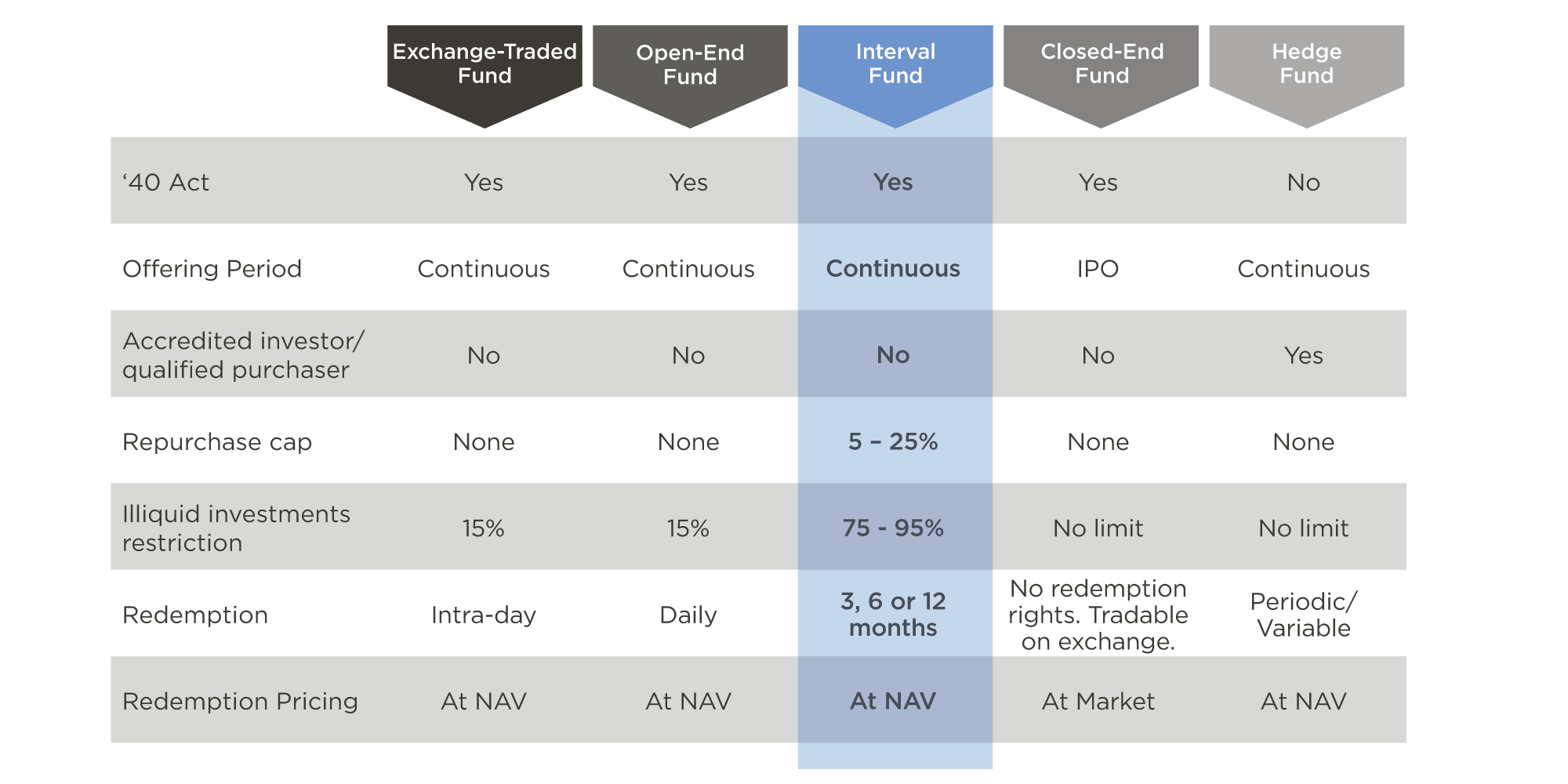Interval Funds 101
Destra Capital
August 28, 2020What is an Interval Fund?
An interval fund is a fund structure that is being rediscovered by both asset managers and investors. It is technically classified as a “closed-end” fund under the Investment Company Act of 1940 (“‘40 Act”) and while it may take in new investments daily, it only allows redemptions or buy backs at specified intervals, most commonly 5% each quarter. This key differentiator, specified liquidity intervals, allows asset managers to know the maximum amount that might potentially be withdrawn at each interval and thus allows the managers to hold illiquid or less liquid assets without fear of excess short-term redemptions.
Other differentiators between traditional closed-end funds and interval funds are:
- They provide investors with the ability to invest in liquid (marketable) and non-liquid (non-marketable) investments.
- They can invest some or all of a portfolio into illiquid investments while the quarterly interval redemption program provides potential flexibility for investors to access their capital.
- Their shares typically do not trade on the secondary market. Instead, their shares are subject to periodic repurchase offers by the fund at a price based on net asset value.
- They are permitted to continuously offer their shares at a price based on the fund’s net asset value (and many do).
The table below provides a brief comparison of various structures. Note that interval funds allow limited liquidity (5 – 25%) and the ability to invest in illiquid or less liquid investments, much like hedge funds, but with the structure and protections of the ‘40 Act. Exchange listed closed-end funds also provide for the use of illiquid investments, but investors’ purchase and sale is subject to market prices on the exchange which can be significantly different (premium or discount) to the fund’s NAV. Open-end and exchange-traded funds are limited to 15% in illiquid investments. Interval funds occupy an attractive middle ground between daily vehicles, which have tight restrictions on less liquid assets, and hedge funds, which have less uniform or regulated formats.

What are the liquidity rules and redemption policies associated with interval funds?
An interval fund will make periodic repurchase offers to its shareholders, generally every three, six, or twelve months, as disclosed in the fund’s prospectus and annual report. The interval fund also will periodically notify its shareholders of the upcoming repurchase dates. When the fund makes a repurchase offer to its shareholders, it will specify a date by which shareholders must accept the repurchase offer. The actual repurchase will occur at a later, specified date.
The price that shareholders will receive on a repurchase will be based on the per share NAV determined as of the specified (and disclosed) date. This date will occur sometime after the close of business on the date by which shareholders must submit their acceptances of the repurchase offer (but generally not more than fourteen days after the acceptance date).
What types of investments can be held in interval funds?
Subject to terms of the prospectus, interval funds can invest in a number of different assets classes including, but not limited to, stocks, mutual funds, exchange-traded funds (ETFs), bonds, traded and non-traded real estate investment trusts (REITs), traded and non-traded business development companies (BDCs), traded and non-traded master limited partnerships (MLPs), currencies, private placements, and other securities.
Who should invest in interval funds?
Interval funds are designed specifically for investors with a moderate-to-high risk tolerance, a mid-to long-term time horizon, and ample liquidity elsewhere in their portfolio due to the nature of the quarterly redemption intervals and underlying investments.
Investors seeking to diversify their portfolio to alternative investment strategies that include real estate, business development companies, master limited partnerships, covered call writing, and preferred stocks may benefit from the fund’s diversified approach.
Interval funds are complex investment instruments that can contain a variety of investment types. Investors should be cautious when investing in interval funds due to the liquidity features and characteristics of the underlying investments. Investors should work closely with their financial advisors to determine if interval funds are suitable for their portfolios and economic situations.
How can interval funds be used in a portfolio?
- Interval funds can be used to gain access to investments, industries, and sectors that investors may not normally have access to due to accreditation requirements.
- Since the investments held in interval funds are usually less liquid than those held in other types of funds and are concentrated in alternative asset classes, they must be used carefully.
- We recommend clients consult with an investment advisor to determine which types of interval funds and focuses are most appropriate for a given portfolio (as everyone's economic and personal situation vary).
- Interval funds are commonly used as a core holding to gain exposure to a specific sector of the market. This core holding can be complemented with individual holdings as well. This is often referred to as a “core/ satellite” allocation. For example, if a client would like to gain broad market exposure to alternative asset classes while still focusing on a specific sector of the real estate market such as healthcare or hospitality, he or she might choose an interval fund with a real estate focus for their “core” allocation, then purchase an individual healthcare or hospitality REIT as a “satellite” allocation.
- investors using interval funds as a core holding in combination with other alternative investments may achieve greater diversification, lower risk, and increased liquidity over a portfolio solely consisting of illiquid alternative investments and direct participation programs.
Potential Advantages
- Active management across multiple assets classes and investments adds increased diversification
- Greater ability to invest in less liquid assets such as non-traded REITs, BDCs, MLPs, and private placements
- Access to investments that may only be available to accredited investors*
- Potentially higher yields
- Ability to increase exposure to a variety of alternative asset classes without large capital commitments and increased liquidity
- Potential reduction of “investment headline” risk**
- Potential to dilute the negative impact of a particular investment within the fund
*Investors who are financially sophisticated and have a reduced need for the protection provided by certain government filings. See www.sec.gov for further explanation.
**The possibility that a news story will adversely affect a stock’s price.
Potential Disadvantages
- Advisors selling interval funds may not appropriately disclose the advantages and disadvantages and/or potential conflicts of interest. Investors should work closely with an advisor who will properly determine the suitability of interval funds.
- Limited liquidity (usually limited to quarterly or annual redemptions)
- Potential lack of detailed transparency with advisor and sub-advisor
- Potentially higher internal fee structure versus other types of funds
A Manager’s Perspective on Closed-End Interval Funds
“We live in the least liquid bond markets in history. That’s not a bad thing – it means an “illiquidity premium” is available to investors and interval funds, a ‘40 Act structure, offer an efficient way to access these opportunities.”
- Blair Reid, Portfolio Manager, BlueBay Asset Management
From a fund manager’s viewpoint, interval funds possess a number of desirable characteristics:
- Interval funds enhance the ability for investors to earn an “illiquidity premium”:
One key advantage of the structure is the ability for an asset manager to expose investors to less liquid opportunities which may offer higher long-term returns. As the structure gives the manager visibility on the maximum potential outflow, less liquid opportunities can be held without fear of having to sell unexpectedly at unattractive prices. - Advantageous for liquid opportunities with longer time horizons:
Fund managers often have ideas which take months, or longer, to play out. These opportunities can be in liquid securities, though time horizon is required to maximize the gain. The interval fund structure facilitates managers incorporating these opportunities in the knowledge they are unlikely to have to be sold prematurely. - Longer-term investment* vehicles:
Like mutual funds and exchange-traded funds, offer daily or even intra-day liquidity. Looking out over 20+ years for example, a daily liquid vehicle would give an investor 5000+ liquidity points over the life of the investment (approximately 250 trading days per year x 20 + years); an interval fund might offer only 80 or so liquidity points in the same example (quarterly liquidity 4 x year x 20+ years). Many investors have a tendency to sell when prices decline, crystalizing losses and increasing transaction costs. Interval Funds, with their periodic redemptions windows, encourage investors to take a longer term perspective, which is usually more consistent with their investment horizon.
